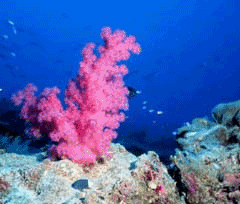New studies reveal surprises about deep sea corals and their past

New research shows that the second most diverse group of hard corals first evolved in the deep sea, and not in shallow waters. Stylasterids, or lace corals, diversified in deep waters before launching at least three successful invasions of shallow water habitats in the past 30 million years. This finding contradicts a long-established theory that suggests corals and other marine animals all evolved in shallow water before migrating into deeper habitats.
“When we look at the DNA and fossils of these animals, we can trace how these transitions from deep water to shallow habitats have popped up in different parts of the family at different points in time,” says Alberto Lindner, a coral researcher at the University of São Paulo, Brazil. “We also see this story unfold in which the corals are building skeletal defenses in what looks like a long-running arms race with their predators. Together, it shows us how wrong it is to think of deep-sea ecosystems as being isolated and static.”
Lindner and a panel of researchers will discuss these and other new discoveries about deep-sea corals at a press conference at the American Association for the Advancement of Science (AAAS) Annual Meeting in Boston, MA, on Thursday.
Regardless of where they evolved, the corals living in these habitats continue to surprise researchers. “Deep-sea corals can be spectacularly long-lived, which makes them critical contributors to our efforts to understand the past,” says Brendan Roark, a paleoceanographer at Stanford University. “Our radiocarbon dating shows that some species have life spans of over 4000 years. That means some coral colonies have been alive since Stonehenge was erected. These animals are living antiquities.”
Many corals grow their skeletons in a manner similar to tree trunks, laying down growth rings that become historical archives of the water conditions over time. Analyzing the chemical composition of these layers allows researchers to trace changes in ocean circulation and temperature over hundreds to thousands of years. Such historical reconstructions are critical for understanding how climate change occurred in the past, and for making predictions about the future.
Roark’s finding on growth rates and longevity also challenge the adequacy of old models upon which the management of deep-sea coral species are based. “Growth rates have been overestimated by an order of magnitude in some fisheries management plans. Our new understanding of the great longevity of some of these species strongly suggests the need for more rigorous measures to ensure their populations are adequately protected.”
Research in these habitats is expensive and difficult, often leading to studies that are geographically constrained and impossible to compare. In an attempt to overcome these challenges, J. Murray Roberts of the Scottish Association for Marine Science will unveil plans for a novel international scientific program called the Trans-Atlantic Coral Ecosystem Study (TRACES).
The project will be the first to trace the flow of genes and animals across the seafloor communities of an entire ocean basin. TRACES researchers from Canada, the U.S., and the European Union will conduct exploratory cruises across the North Atlantic to study the environmental and ecological history of deep-sea communities beginning in late 2008.
Whereas Lindner’s work is concerned with how species evolved in the distant past, the TRACES geneticists are focused on tracking relatively recent changes in populations. Other TRACES researchers will expand upon Roark’s work; by collecting a large library of the isotope records stored in coral skeletons, they will be able to study historical climate change and create new models with better resolution than ever before.
“We must cross national boundaries to understand deep-sea coral ecosystems. The only way we can work out how to protect deep-sea corals is to understand how they are distributed and connected,” Roberts says. “Since we started work on TRACES we’ve been amazed at the response of the scientific community. Over 100 scientists are already involved and our first meetings are over-subscribed. Everyone agrees we owe it to future generations to make sure these unique ecosystems are protected by conservation plans based on sound science.”
Source: SeaWeb





















